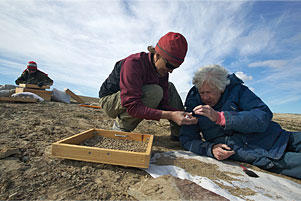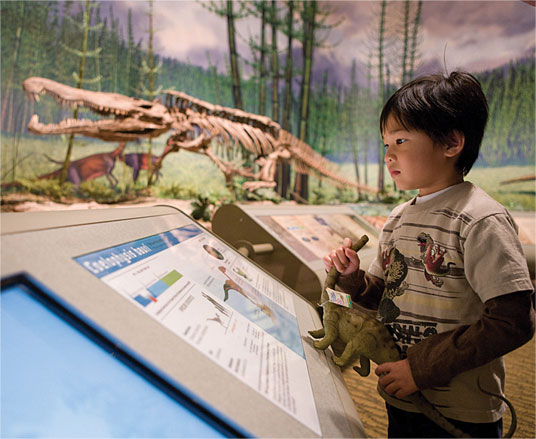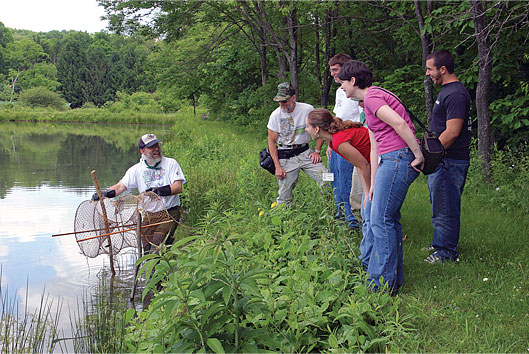|
Clearing a New Path
Now nearly two years in the driver’s seat, director Sam Taylor talks about what’s next for Carnegie Museum of Natural History.
By Julie Hannon
Sam Taylor calls Carnegie Museum of Natural History’s treasure trove of collections and research the engine that drives the museum’s progress. “Without our research programs,” says Taylor, the museum’s director since April 2008, “we’d have nothing to talk about.” On the heels of a 6-month-long strategic planning process, priority number one he says is jumpstarting efforts to connect the public with the current work of the museum’s world-renowned scientists—work that will keep the museum fresh and relevant and able to tackle the next big questions in science: biodiversity, sustainability, and global climate change, among them.
Taylor and his staff are busy reimagining not only how the museum will continue to fund its cutting-edge science but how it will most effectively communicate about it, with greater emphasis on experimentation, evaluation, and visitor input. Starting where Dinosaurs in Their Time left off, the idea is to infuse a more collaborative, think-outside-the-box effort into everything the museum does.
 "All of the big environmental questions that we face—whether it’s habitat loss, biodiversity, the loss of species, or global climate change—our scientists are doing work around the globe that is generating information that will inform exactly those kinds of real-world decisions." "All of the big environmental questions that we face—whether it’s habitat loss, biodiversity, the loss of species, or global climate change—our scientists are doing work around the globe that is generating information that will inform exactly those kinds of real-world decisions."
An unfolding example, notes Taylor, is Population Impact, a new exhibition opening in January that explores one of the most pressing science topics of our day: the idea that populations don’t grow without consequences and that the choices we make about natural resources impact the future. It investigates human population, tree cloning, and biodiversity through the latest research of a handful of museum scientists. But they alone aren’t driving the exhibition. With visitor feedback in hand, museum researchers, educators, and exhibitions staff are informing the take-home messages. “We want to provide good science and also spark imaginations,” says Taylor. “We want the conversation to continue beyond the exhibition.”
What does Carnegie Museum of Natural History do well and what could it do better?
It’s funny because many times it’s the same items on both lists. I’ll share with you something that comes out of our surveys of the public, as an example. If you ask people what they love most about the museum, you’ll hear things like: ‘You see the camel driver attacked by lions and the expansive dioramas, and it’s wonderful because nothing ever changes. I just love coming in and seeing the dinosaurs, it’s just like when I was a kid.’ Then you ask people what they dislike, and they tell you: ‘It’s the same as when I was a kid. You go in and you see the camel driver, and you see the dioramas, and nothing has changed much and it’s kind of old and dusty.’ Museum scientists are making a big impact, around the world and right here in Pittsburgh. At right, Mary Dawson, curator emerita of vertebrate paleontology, and a Canadian colleague discover a small, carnivorous mammal in a 23-million-year-old lake deposit on Devon Island, Nunavut, Canada.

We do have some iconic exhibits like the camel driver and the dioramas, talismans to people’s memories. But, in fact, very little of this place is like it was when most of us were kids. The dinosaurs are a completely new display in a completely new exhibit area, cleaned and re-articulated to represent the most recent science—and there are so many more of them! So, yes, the dinosaurs are still here, but what you can learn about them is new and the work that we have done with them, that we continue to do with them, is very visible. So, we have a lot of work to do in terms of communicating the contemporary view of what we’re up to here at the museum.
What kinds of things do you want to highlight?
We need to tell the public about the research that goes on here, the quality of that research, and why our collections are significant not only to Pittsburgh but to the entire world. Because the knowledge that’s generated here is the kind of knowledge that the world needs to inform the future. All of the big environmental questions that we face—whether it’s habitat loss, biodiversity, the loss of species, or global climate change—our scientists are doing work around the globe that is generating information that will inform exactly those kinds of real-world decisions. So, over the next three years we’ll be launching a series of exhibitions, public programs, and marketing tools that tell these stories.

Dinosaurs in Their Time highlights work of museum scientists, including the real fossil skeletons of a well-known early dinosaur, Coelophysis—laid out just as Dave Berman, vertebrate paleontologist, found them in 1981.
Photo: Joshua Franzos
One of the things you identified early on as a priority was endowing curatorial positions that have been vacant for some time. Why is this so important, and have you made progress?
I like to call our research program the engine that runs the place. Through our research programs, we collect, we study the world, we study the organisms that live in the world, and we study the different habitats around the world. And the curators are the people who lead those research efforts, the ones who make the collections, and the ones who are really determining what our museum message is. From my perspective, these are the most critical positions for the museum’s lifeblood and it’s really important that we work to protect them.
We’ve received support from the Heinz Endowments for a curator of herpetology, which is a position we plan to fill in the coming year, and a conservation biologist at Powdermill. We have a generous bequest that takes us more than halfway towards fulfilling a second endowed position in the vertebrate paleontology department. And we’ll continue to build on these efforts.
How are you planning to financially support new initiatives, especially in this tough economic climate?
One of the strategic directions that we emphasize in our new plan is to put lots and lots more effort into seeking federal funding. Based on our areas of expertise, the National Science Foundation (NSF) is number-one among those that have money for the kind of work that we do, both in research and public education. I’ve already made it a priority for staff to put more effort into learning how to write good proposals and into helping one another create a culture of teamwork when preparing proposals. At this point last year, we had two NSF proposals that were supporting the work of the museum, both in the research area. This year, we have 14 proposals pending, 11 with NSF and two with the Institute of Museum and Library Services. We also just received funding from NASA to benefit our education department. This represents an incredible effort on the part of our staff, because if we’re lucky, maybe a third of them will be funded, and that could take us a long way towards our goal of stable funding for science.
How do you view the museum’s role in the community?
While Carnegie Museums is already doing a lot, of course we could do a lot more. At the Museum of Natural History, we’re working hard on our partnerships with our university neighbors. For example, we’re working with the Pitt Honors College to develop programs in paleontology education out of their Cook Ranch property in Wyoming. This is a 6,000-acre preserve owned by the Pitt Honors College which has extraordinary dinosaur fossils on it, archeological sites, and abundant wildlife that present incredible opportunities for field study. We’re working to develop programs for undergraduate research as well as a program for high school students to have a field experience there next summer. This is one way our expertise can be leveraged to provide greater educational opportunities.
With Carnegie Mellon University, we are developing a program that I’m calling the Experimental Gallery, a way of getting young minds and innovative technology to tell our story of current science. Working initially with the School of Design, each semester we’ll provide a group of their students with one of our current science stories—something hot off the press, like a new discovery. We’ll give them a budget, and they’ll develop an exhibition about that science story, which we will then display at the museum. Exhibitions will rotate out every six months, and the idea is to get more students involved with the museum and to create a kind of buzz with something new, using experimental technologies that we might not have considered ourselves. The Fine Foundation is funding the pilot semester this spring.
Did you consider community needs in your planning process, including those of the Pittsburgh Public Schools?
Definitely. This past fall, the Pittsburgh Science and Technology Academy opened near the museum. We’re working closely with their administrators and teachers so that the museum can be a big part of the curriculum and future student-driven research projects. We’re currently arranging for all of their teachers to have free access to the museum, to come in early in the morning or late in the afternoon to use the museum’s resources as though they were their own, so they’re able to direct their students to the right places in the museum to study topics of interest.

Turtle trapping is always a highlight at Powdermill’s annual Bioforay, an event that invites the scientifically- curious to work alongside museum scientists as they survey and document the reserve’s 2,200 acres.
Photo: Mindy McNaugher
In looking at the needs of the broader community, I’m really happy to report that we’ve just received a generous grant from The Pittsburgh Foundation to conduct a broad-based assessment of community needs throughout Pittsburgh. Using this funding, we will begin a process of systematically bringing in representatives from different neighborhoods, from different interest groups, from the schools, from volunteer agencies, and from social service agencies to really generate a dialogue for a number of months. The goal is to better understand people’s perceptions about the museum, how they would define their needs, and where exactly is the overlap between our mission and community needs that aren’t being met right now.
Are there any collaborations in the works with the other Carnegie Museums that really excite you?
One thing that grew out of our recent cross-museum planning is the idea of having all four museums do programming or exhibitions related to a traveling exhibition titled RACE—Are We So Different?, which we’ll host at the Museum of Natural History in 2012. The exhibition examines race from a historical point of view, from a biological point of view, and in the ways in which it plays out in society. The two art museums and the Science Center are all looking at exhibitions or programs related to topics of identity within our community. It’s an opportunity to do something really meaningful.
"Dinosaurs are truly an incredible hook; other museums would love to have what we have, period. But we also have a lot of work to do to expand our image so that it encompasses a much broader spectrum of natural science topics."
Are there inherent strengths and weaknesses to being known as the “dinosaur museum?”
Dinosaurs are truly an incredible hook; other museums would love to have what we have, period. But we also have a lot of work to do to expand our image so that it encompasses a much broader spectrum of natural science topics. One that’s especially important to me and that we clearly have the resources and the platform to do is bringing conservation, sustainability, and stewardship of the land into our mission and into our message.
Is that where Powdermill Nature Reserve fits in?
Powdermill is our platform for programs and research that align conservation with the museum’s mission. But we haven’t done a very good job of letting people know that Powdermill is a part of Carnegie Museum of Natural History. And so, again, another major direction that comes out of our strategic plan is to unify the mission and programs of Powdermill with Carnegie Museum of Natural History so that there is a single, seamless organization and that conservation and a look towards the future is as much a part of this museum’s work as is looking at the past.
Your Ph.D. focused on studying visitors, and you also worked as director of exhibitions at a major museum. How is that experience influencing your work now?
We’re providing professional development to our public programming staff to grow their know-ledge of ‘inquiry’ learning. Inquiry learning is experiential learning, and it has to do with people discovering facts and being able to make sense of them on their own, rather than just by reading a label and being told this is a dinosaur that lived 65 million years ago. This will impact the way we put together exhibits, so that we lead visitors through experiences that allow them to discover things on their own. It will also impact how our staff designs public programs and structures interactions with visitors. All of it is based on the concept of inquiry, which is appropriate in a scientific organization because it mimics the scientist’s process of discovery—of asking questions and looking for evidence to reach conclusions about how the world works. We want that same process, at some level, to be happening with our visitors.
We’re also working toward a culture of evaluation and experimentation. So, as we develop programs and exhibitions, we allow ourselves to try new things, new ways of communicating, at a very early stage. We might create a prototype, put it out on the exhibit floor, and ask people to react. And then see how closely the reaction aligns with what we’re hoping to achieve and then we make adjustments as we go along. From my perspective, if people don’t get it, there’s something wrong with the way we’ve tried to deliver the message.
What might surprise people to learn about the Museum of Natural History?
I have this idea that we ought to have a marketing campaign that is based on 365 days at the museum, and every day we show an object that is on permanent display here. We could remind people that, any day of the year, you can come and see this incredible priceless gem, any day of the year you can come and see this endangered species of animal, any day of the year you can come and see this exhibition on ancient life. People could literally come to the museum every day and see something different.
|

 "All of the big environmental questions that we face—whether it’s habitat loss, biodiversity, the loss of species, or global climate change—our scientists are doing work around the globe that is generating information that will inform exactly those kinds of real-world decisions."
"All of the big environmental questions that we face—whether it’s habitat loss, biodiversity, the loss of species, or global climate change—our scientists are doing work around the globe that is generating information that will inform exactly those kinds of real-world decisions."



